Inpatient census 2022: hospital based complex clinical care and long stay
Results from the Hospital Based Complex Clinical Care (HBCCC) and Long Stay Census, carried out in April 2022. The data was collected as part of the Inpatient Census.
1. Hospital Based Complex Clinical Care and Long Stay Patients
Number of HBCCC and Long Stay patients in Census
Overall, there were 1,250 Hospital Based Complex Clinical Care (HBCCC) or Long Stay (LS) patients at the 2022 Census. Of these, 575 (46%) were receiving HBCCC and 675 (54%) were LS. LS is defined here as patients in hospital for at least 6 months with no delayed discharge date but not in receipt of HBCCC.
Of the 1,250 HBCCC or LS patients, 949 (76%) were occupying a Mental Health, Learning Disability or Addiction Inpatient Bed in an NHS Scotland facility, 143 patients (11%) were in a General Acute / Community Hospital NHS Scotland facility, while 158 patients (13%) were treated outwith but funded by NHS Scotland (e.g. Private hospitals or NHS facilities elsewhere in the UK). Table 1 provides a more detailed breakdown and comparisons to 2019 data. There are also a very small number of patients treated within NHS Scotland but funded externally.
Please note: the figures given in this publication for HBCCC patients differ from those given in the Mental Health Inpatient Census parts 1 & 2. This is because in Parts 1 & 2, they refer only to HBCCC patients with mental health diagnoses, whereas in Part 3 they refer to all HBCCC patients.
| Inpatient Census | All Patients | HBCCC Patients | LS Patients | |||
|---|---|---|---|---|---|---|
| 2019 | 2022 | 2019 | 2022 | 2019 | 2022 | |
| Part 1: Mental Health Bed Census | 1,305 | 949 | 684 | 409 | 621 | 540 |
| Part 2: Out of Scotland NHS Placements | 91 | 158 | 41 | 86 | 50 | 72 |
| Part 3: HBCCC & LS (General Acute) | 239 | 143 | 164 | 80 | 75 | 63 |
| All HBCCC patients in Inpatient Census | 1,635 | 1,250 | 889 | 575 | 746 | 675 |
Age and Gender
Figure 2 shows the age and gender breakdown of patients receiving HBCCC at the 2022 Census. Some key points include:
- Of the 575 HBCCC patients, 308 (54%) were male, while 267 (46%) were female. Males represented 49% of the general Scottish population in 2021 based on National Record of Scotland (NRS) Mid-Year estimates, suggesting males are over represented in HBCCC.
- Patients were mostly from the older age group, 350 (61%) patients were aged 65 or over, a rise from 59% in the 2019 Census. A further 118 (21%) patients were aged 40 – 64 and 78 (14%) patients were aged 18 – 39. There were 29 (5%) patients under 18 years of age receiving HBCCC at 2022 Census, four percentage points higher than 2019.
- The gender differences described are influenced by age. At the 2022 Census, of the patients aged under 40, 51% were male. This is 10 percentage points less than at the 2019 census. However, the large majority of patients aged under 18 years were female. Of those aged 40 – 64, 64% were male and at 65 or over the gender split becomes more even with 51% males and 49% females.
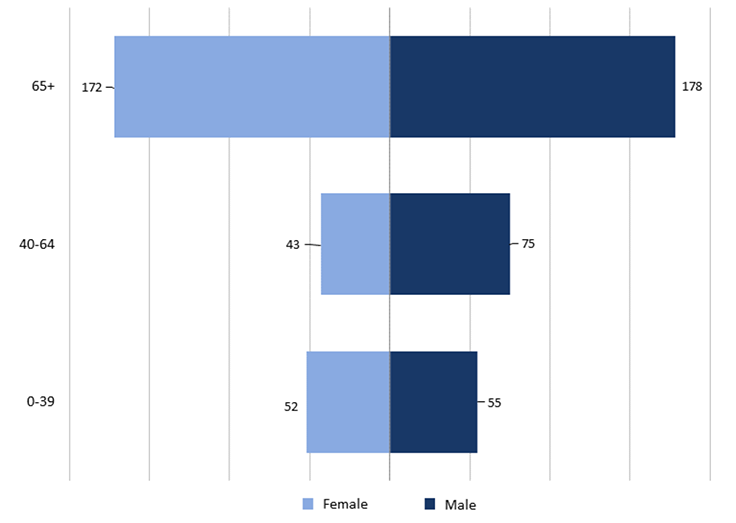
Hospital Based Complex Clinical Care & Long Stay, NHS Scotland, April 2022 Census
Figure 3 (below) shows the age and gender breakdown of LS patients at the 2022 Census. Some key points include:
- Of the 675 LS patients, 444 (66%) were male, while 231 (34%) were female. Males represented 49% of the general Scottish population in 2021 based on NRS Mid-Year estimates, suggesting males are over represented.
- Patients were mostly from the 40 – 64 years age groups with 301 (45%) patients, the same proportion as the 2019 Census. There was a further 165 (24%) patients aged 65 or over. There were 209 (31%) LS patients aged under 40 at the 2022 Census.
- The gender differences described are influenced by age. For patients aged under 40, 67% are male, while a similar proportion of patients aged 40 – 64 years, 69%, are male. The proportion for the 65 or over age group is 58% male.
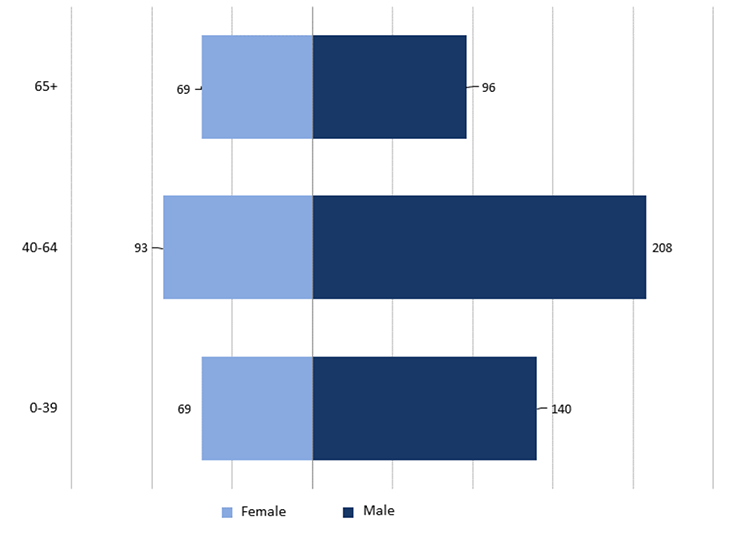
Hospital Based Complex Clinical Care & Long Stay, NHS Scotland, April 2022 Census
Ethnicity
The majority of HBCCC or LS patients at the 2022 Census, described themselves as being of White Scottish ethnicity, 820 (66%). A further 170 (14%) patients were of another White ethnicity. Information was not known or refused for 219 (18%) patients. See figure 4 for further details.
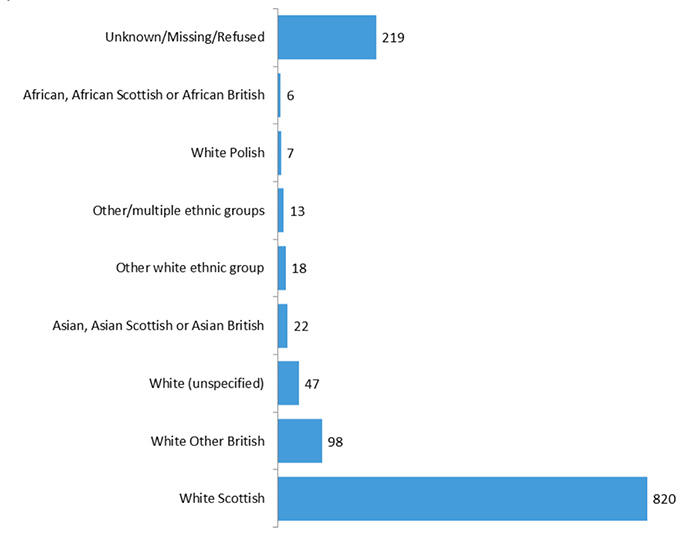
Hospital Based Complex Clinical Care & Long Stay, NHS Scotland, April 2022 Census
Consultant Specialty
As part of the Census, NHS Boards were asked to record the medical specialty of the consultants responsible for overseeing the treatment of each patient in the Census.
Of the 575 patients receiving HBCCC at the 2022 Census, 230 (40%) had a consultant who specialised in Psychiatry of Old Age, showing a continuing fall from 43% in 2019 and 47% in 2018, but remaining higher than the 2017 figure of 36%. In 2022, 90 patients (16%) had a consultant specialising in General Psychiatry and 62 (11%) in Geriatric Medicine. See figure 5 for further details.
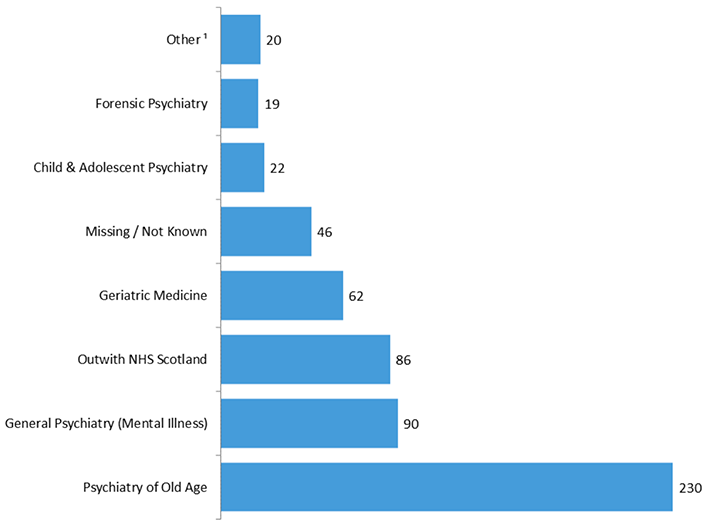
Hospital Based Complex Clinical Care & Long Stay, NHS Scotland, April 2022 Census
¹ Other includes a range of specialties with smaller numbers that have been aggregated to protect patient confidentiality
Of the 675 LS patients at the Census, 232 (34%) had a consultant who specialised in General Psychiatry, 169 (25%) had a consultant specialising in Forensic Psychiatry and 73 (11%) in Psychiatry of Old Age. See figure 6 for further details.
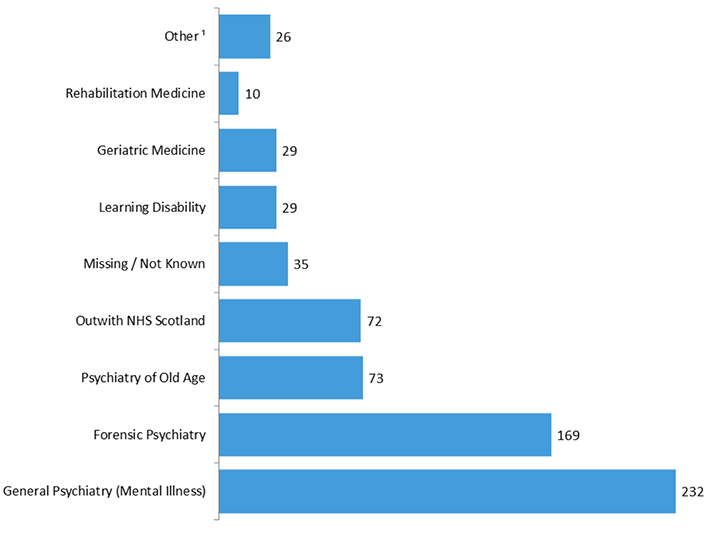
Hospital Based Complex Clinical Care & Long Stay, NHS Scotland, April 2022 Census
¹ Other includes a range of specialties with smaller numbers that have been aggregated to protect patient confidentiality as well as patients with a missing or unknown specialty
NHS Board Breakdown
NHS Greater Glasgow & Clyde were responsible for funding the treatment of 182 HBCCC patients (32%), followed by NHS Lothian with 150 HBCCC patients (26%). NHS Greater Glasgow & Clyde's proportion has decreased by one percentage point from the 2019 Census, while NHS Lothian has decreased by five percentage points. NHS Shetland funded no HBCCC patients. A very small number of patients are included in this analysis that are treated in Scotland but funded from outside of NHS Scotland. See figure 7 for further details.
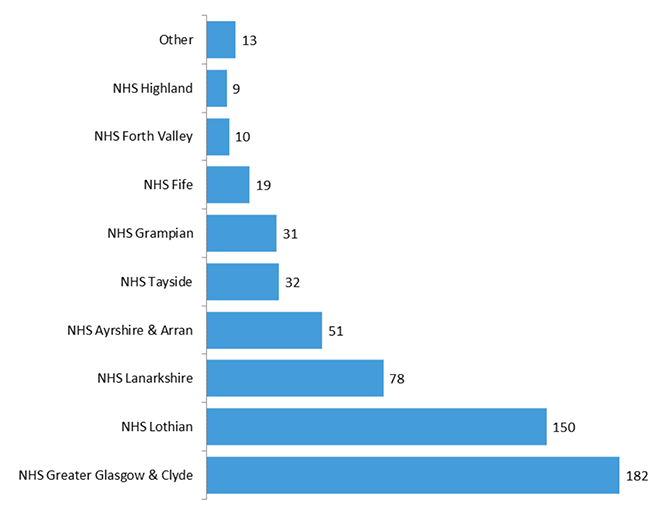
Hospital Based Complex Clinical Care & Long Stay, NHS Scotland, April 2022 Census
* Other includes NHS Boards with small numbers that have been combined to protect patient confidentiality
** A very small number of patients are included in this analysis that are treated in Scotland but funded from outwith NHS Scotland
NHS Lothian had the highest rate of HBCCC patients at 16.4 per 100,000 population. This is a fall from the 30.6 patients per 100,000 population funded by NHS Lothian at the 2019 Census. NHS Greater Glasgow & Clyde and NHS Ayrshire & Arran had the next highest rates at 15.4 per 100,000 and 13.8 per 100,000 respectively. See figure 8 for further details.
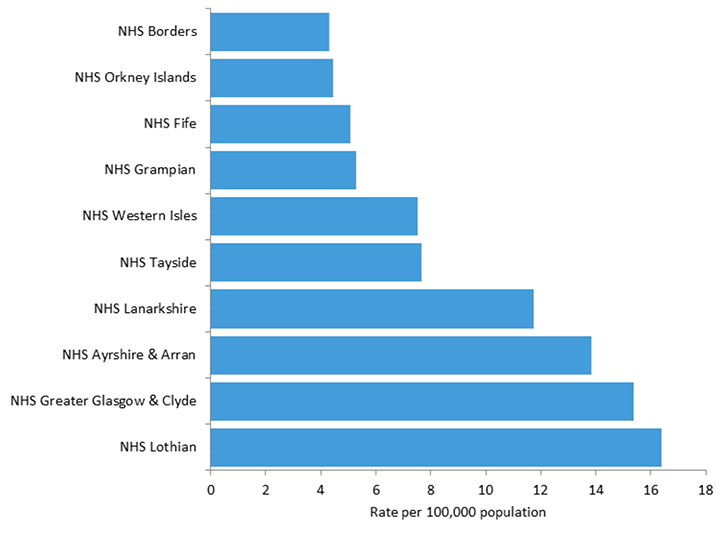
Hospital Based Complex Clinical Care & Long Stay, NHS Scotland, April 2022 Census
* Excludes Health Boards that have been suppressed to protect patient confidentiality
NHS Greater Glasgow & Clyde were responsible for funding the treatment of 183 LS patients (27%). The proportion of LS patients funded by NHS Greater Glasgow & Clyde is four percentage points higher than in 2019. NHS Lothian funded the next highest number of LS patients with 146 (22%). See figure 9 for further details.
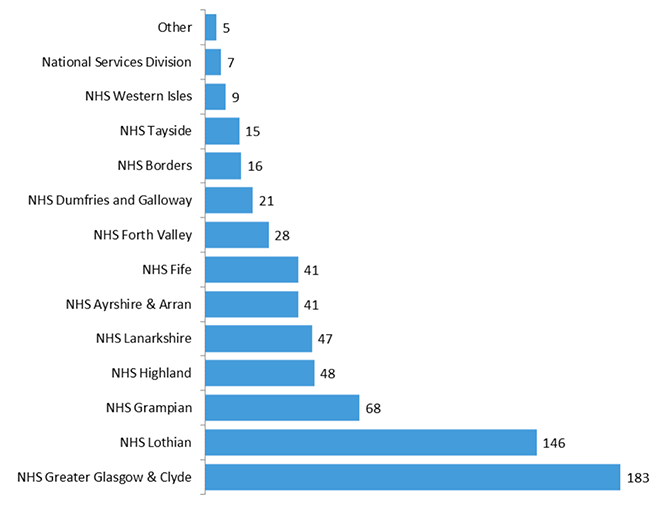
Hospital Based Complex Clinical Care & Long Stay, NHS Scotland, April 2022 Census
* Other includes NHS Boards with small numbers that have been combined to protect patient confidentiality
NHS Western Isles had the highest funding rate for LS patients at 33.8 per 100,000 population in the 2022 Census. NHS Lothian funded the next highest rate of LS patients at 15.9 per 100,000 population. See figure 10 for further details.
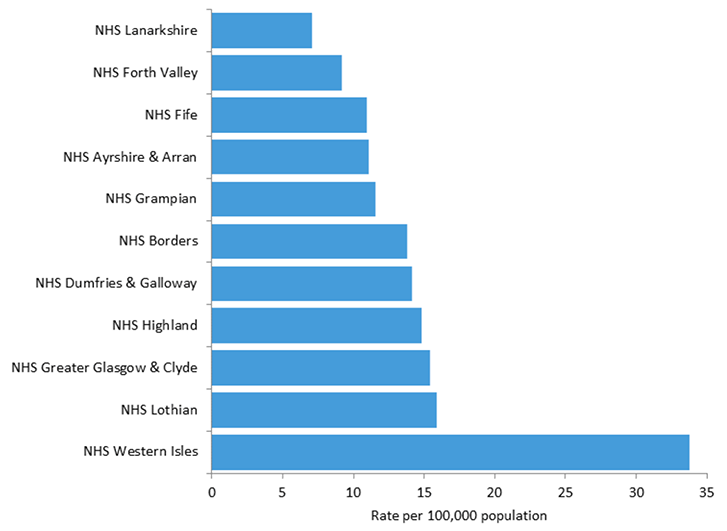
Hospital Based Complex Clinical Care & Long Stay, NHS Scotland, April 2022 Census
* Excludes Health Boards that have been suppressed to protect patient confidentiality
Local Authority Breakdown
Figure 11 provides analysis of patients in receipt of HBCCC by Local Authority of residence (based on the patient's home postcode). Where a Local Authority has less than five patients in receipt of HBCCC the figure has been suppressed to protect patient confidentiality. The City of Edinburgh had more HBCCC patients than any other Local Authority at the 2022 Census with 95 patients (17%). Glasgow City had the next highest number with 72 (13%). The City of Edinburgh's proportion of patients fell slightly from 18% in 2019 and down again from 29% in 2018.
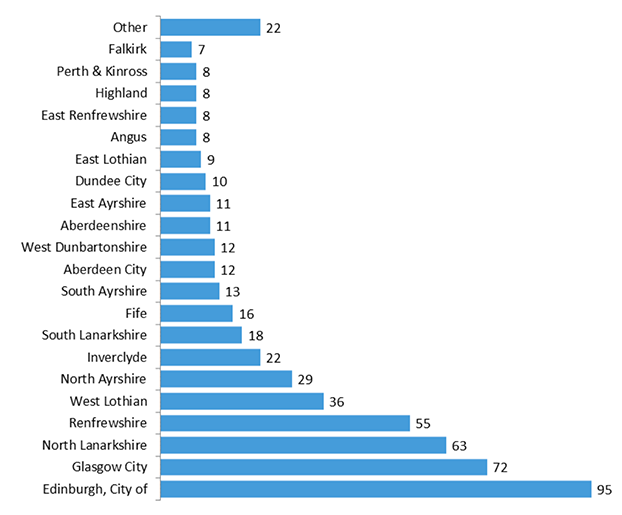
Hospital Based Complex Clinical Care & Long Stay, NHS Scotland, April 2022 Census
* Data unknown for 30 patients
**Other includes Local Authorities with small numbers that have been combined to protect patient confidentiality
Figure 12 provides analysis of LS patients by Local Authority of residence (based on the patient's home postcode). As previously mentioned, where a Local Authority has less than five LS patients the figure has been suppressed to protect patient confidentiality. Glasgow City had more LS patients than any other Local Authority at the 2022 Census with 138 (20%), a six percentage point increase from the 2019 Census. The City of Edinburgh had the next highest with 107 patients (16%), the same proportion as in the 2019 Census
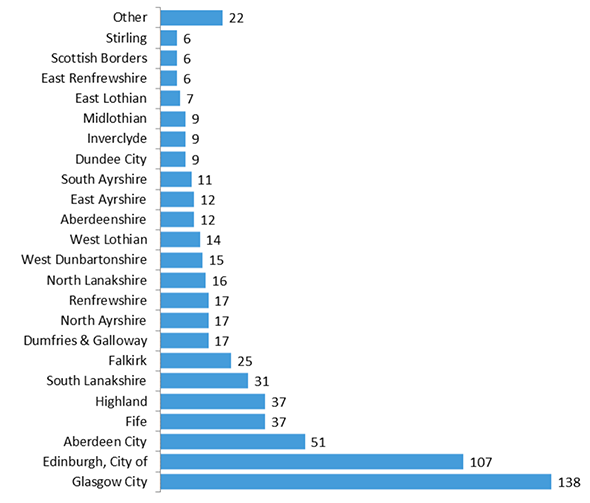
Hospital Based Complex Clinical Care & Long Stay, NHS Scotland, April 2022 Census
* Data unknown for 44 patients
**Other includes Local Authorities with small numbers that have been combined to protect patient confidentiality
Length of Stay in Hospital
NHS Boards were asked to record how long patients had been in hospital at the 2022 Census date. The average (median) time in hospital for HBCCC patients was 498 days (approximately 1 year and 4 months). For LS patients, the average (median) time in hospital was 658 days (approximately 1 year and 9 months). HBCCC median stays are shorter than reported at 2019 Census while LS median stays are longer. The number of patients by year and length of stay can be seen in Table 2.
| Length of Stay | HBCCC Patients | LS Patients | ||
|---|---|---|---|---|
| 2019 | 2022 | 2019 | 2022 | |
| Less than 6 months | 240 | 147 | 0 | 0 |
| At least 6 months, less than 1 year | 129 | 95 | 251 | 210 |
| At least 1 year, less than 3 years | 256 | 138 | 288 | 206 |
| At least 3 year, less than 5 years | 111 | 100 | 76 | 85 |
| 5 years or more | 152 | 95 | 131 | 174 |
| Median | 516 | 498 | 548 | 658 |
* Admission date unknown for 1 patient in 2019
Health Conditions
NHS Boards were asked to return information on any health conditions a patient had been diagnosed with. Figure 13 shows the top seven conditions for HBCCC and LS patients at the 2022 Census. The most prevalent was Mental Health with 496 (67%) HBCCC and 594 (69%) LS patients. Mental Health was also the most common condition in 2019.
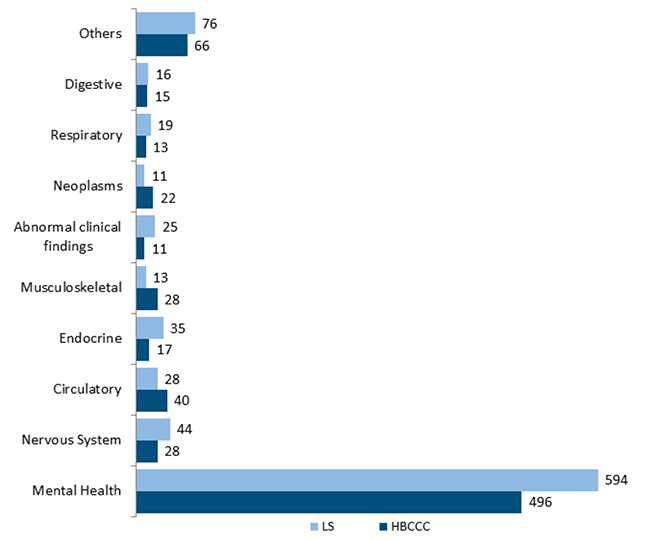
Hospital Based Complex Clinical Care & Long Stay, NHS Scotland, April 2022 Census
* Patients can have more than one condition
Contact
Email: MHIC@gov.scot
There is a problem
Thanks for your feedback